This post may contain affiliate links. For more information, please see our affiliate policy.
This restaurant-style Coconut Shrimp recipe is a cinch to make at home with freezer and pantry staples. My shatteringly-crisp Coconut Shrimp appetizer is good on its own, and even better once dunked into the zippy Sriracha-chile sauce.
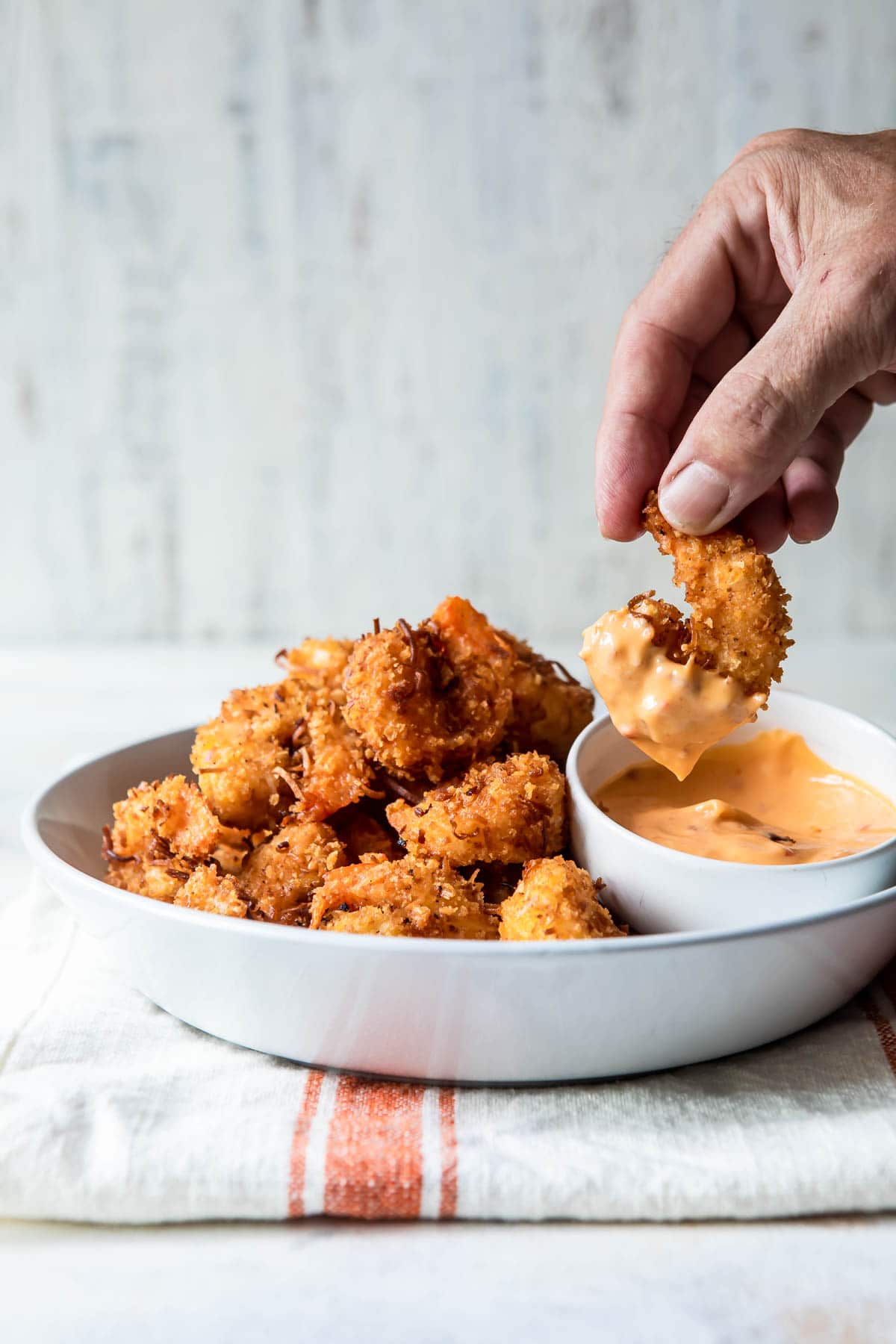
Why save Coconut Shrimp for restaurant meals alone? Inspired by one of my favorite menu items, I’ve leveled-up this Red Lobster copycat recipe with a spicy aioli that elevates each bite to new flavor heights.
Using all freezer and pantry staples, including frozen shrimp, Panko breadcrumbs, and Sriracha sauce, this easy appetizer recipe will talk you through how to recreate the restaurant classic right in your own kitchen. It’s a great recipe to make for dinner tonight, for your next Game Day, or for your next Tropical-themed soireé.
Table of Contents
Recipe ingredients
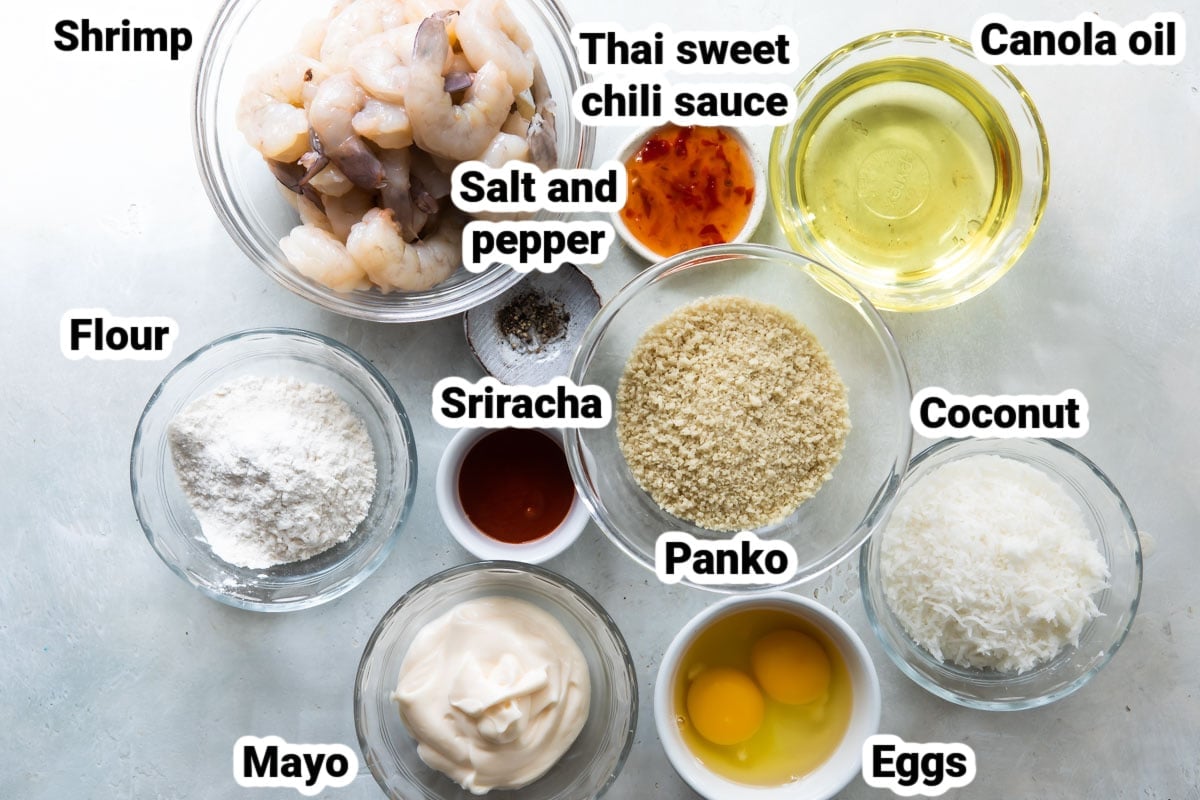
At a Glance: Here is a quick snapshot of what ingredients are in this recipe.
Please see the recipe card below for specific quantities.
Ingredient notes
- Mayonnaise: I adore the rich, umami flavor of Kewpie mayo alongside the sweet chili sauce and spicy Sriracha, but Hellman’s, Duke’s, Kraft, Best Foods, or any brand you prefer is perfect. Just be sure to steer clear of Miracle Whip; it’s too sweet for this purpose.
- Thai sweet chili sauce: More sweet than spicy, this glaze-like condiment is spiked with crushed red pepper flakes. Order a bottle online or look for it in your supermarket near the Sriracha.
- Panko bread crumbs: In most cases, I say you can use regular bread crumbs. Here, however, I think flaky panko is essential. This light Japanese-style breadcrumb is commonly used as to coat for deep-fried foods, including these Coconut Shrimp, for the crispiest results. Buy them at the store or make your own panko crumbs.
- Sweetened shredded coconut: For extra crunch, toast the coconut. Feel free to subsitute unsweetened coconut flakes for the sweetened.
- Jumbo raw shrimp: Raw frozen shrimp (thawed) works beautifully for Coconut Shrimp. To thaw the shrimp, place the bag of seafood in a bowl and transfer it to the refrigerator the night before you plan to make this appetizer recipe. Jumbo shrimp come about 16 to 20 per pound (sometimes labeled U16 to U20). If the shrimp isn’t already peeled and deveined, follow the steps in Frequently Asked Questions for how to clean shrimp.
Step by step instructions
- To make the dipping sauce, in a small bowl, whisk together the mayonnaise, Sriracha, and Thai sweet chili sauce. Chill until serving time.
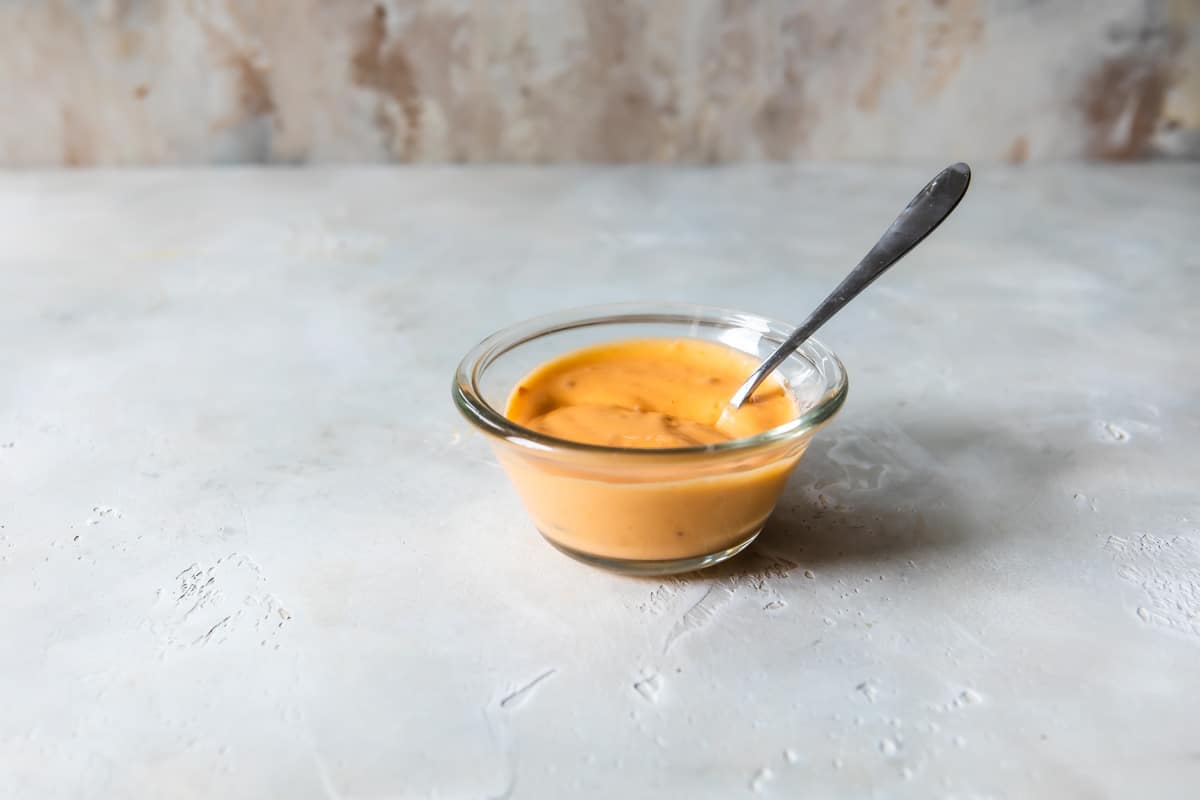
- In a shallow dish, add flour and salt and pepper to taste (I like ½ teaspoon and ¼ teaspoon pepper). In a second shallow dish, add eggs and beat lightly. In a third shallow dish, combine panko and coconut. Stir to combine.
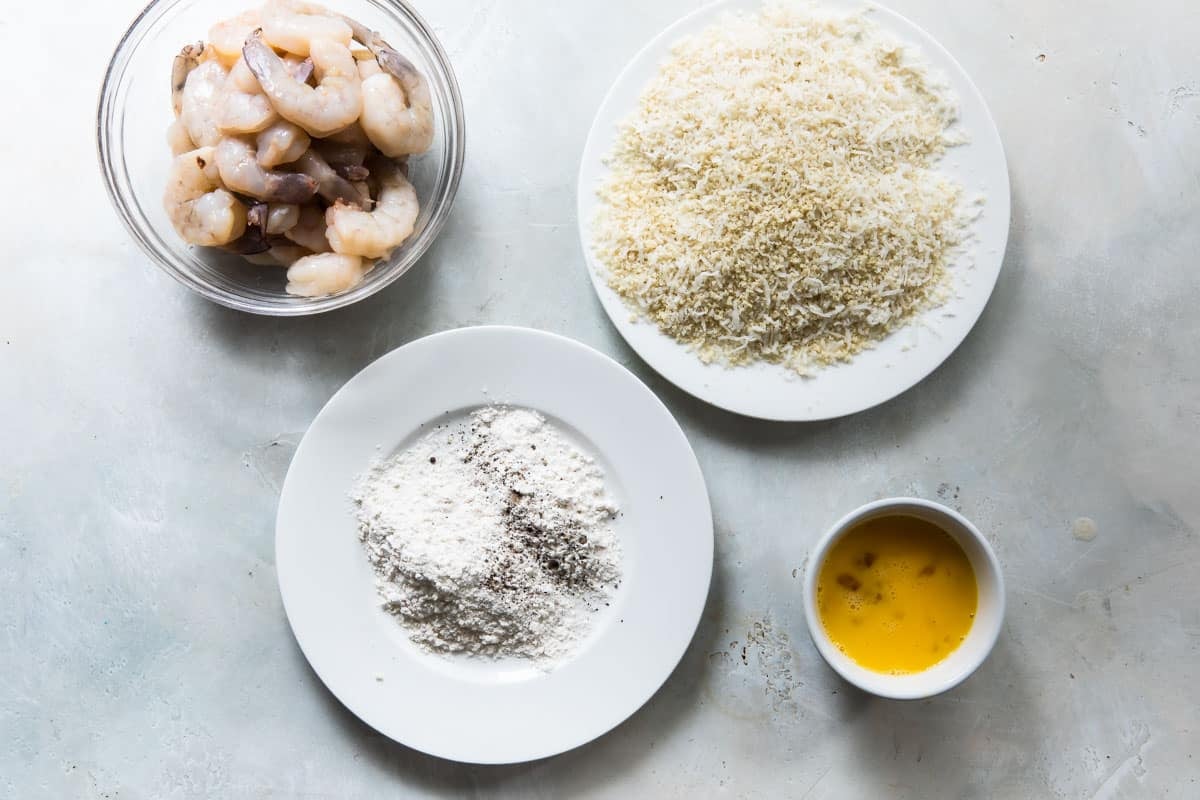
- Working with one shrimp at a time, dredge in flour and shake off excess. Dip in eggs and tap gently on the side of the dish to remove excess. Add to panko-coconut mixture and press gently until crumbs adhere. Transfer to a large plate and repeat with remaining shrimp (shrimp can be wrapped in plastic and refrigerated for up to 2 hours).

- Line rimmed baking sheet or large plate with 3 layers of paper towels. In a large saucepan over medium-high heat, heat canola oil until shimmering. Add shrimp in batches and fry until deep golden brown and cooked through, about 2 to 3 minutes per side (the shrimp should reach 120 degrees on an internal thermometer).
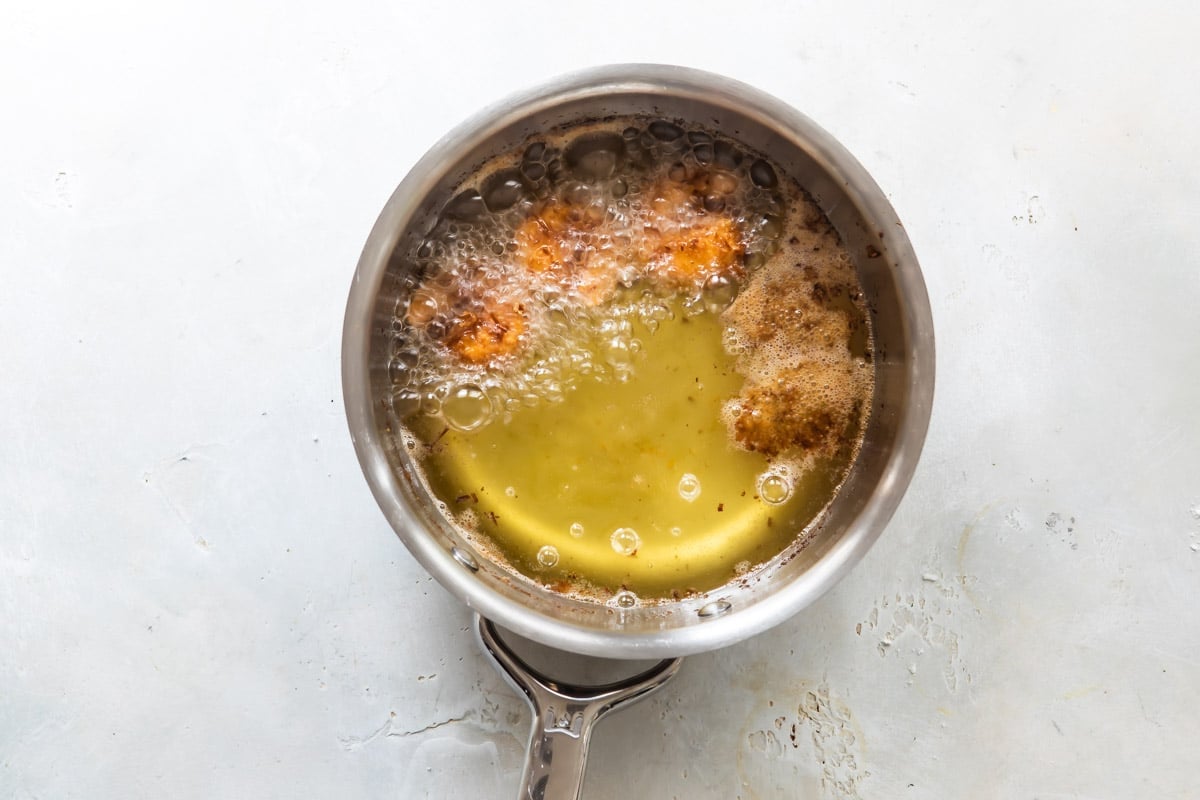
- Drain shrimp well on paper towels.

- Repeat with remaining shrimp and serve with sauce.
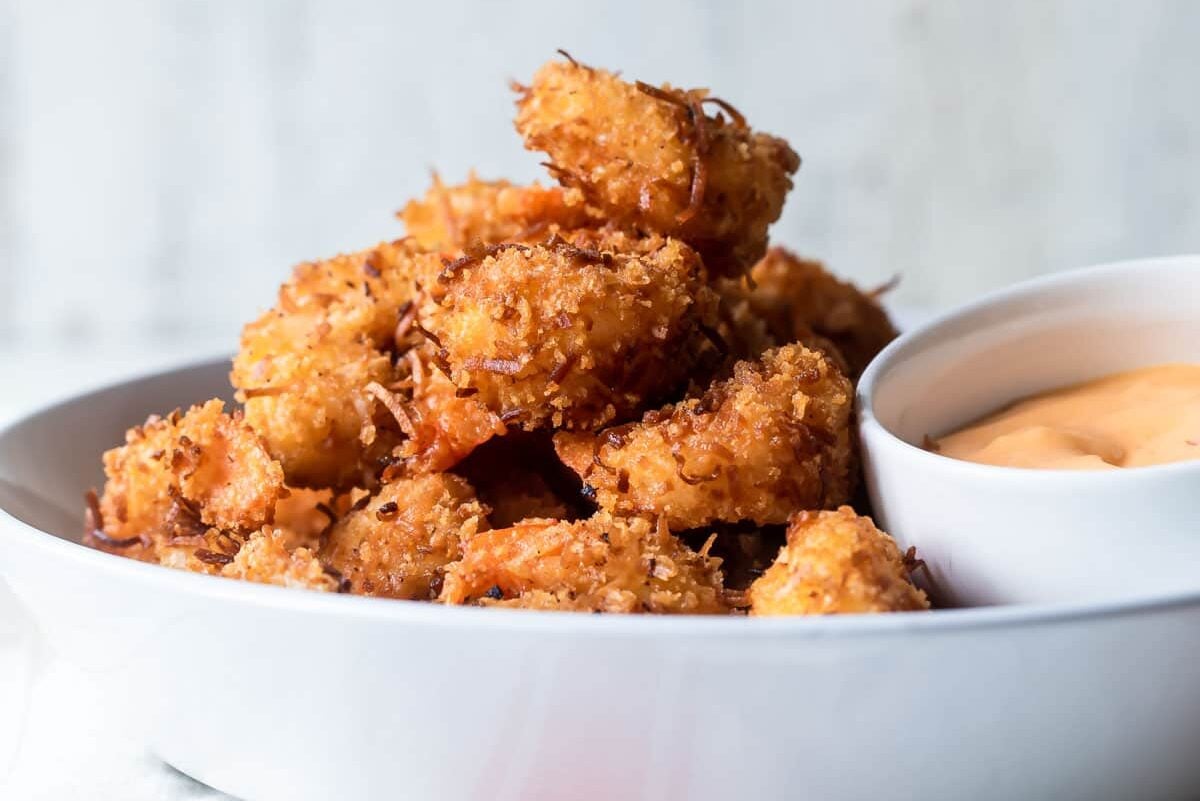
Do I need a deep fryer?
While you can fry Coconut Shrimp on a stove, I like to have a deep fryer on hand if you plan to fry a lot of food. The Cuisinart 4-Quart Deep Fryer is the one I own and love, and it comes to temperature much faster than the stovetop method and creates less splatter. It’s my pick for the best deep fryer, and you can get it for $99.95 at Amazon.
Recipe tips and variations
- Yield: This Coconut Shrimp recipe makes six appetizer-sized servings, about 4 to 5 large shrimp each.
- Storage: Transfer leftover coconut shrimp to an airtight container and refrigerate for up to 3 days. Reheat in the oven or an air fryer to 145 degrees.
- Freezer: Place cooked and cooled Coconut Shrimp to a freezer-safe zip-top bag, label, date, and seal. Freeze for up to 2 months. Reheat in the oven or an air fryer to 145 degrees.
- Fruit dipping sauce: Make a simple dipping sauce of equal parts Thai sweet chili sauce and orange marmalade or apricot preserves. For extra flavor, add a few minced cloves garlic or even some garlic powder.
- Lime: Fresh lime juice (from lime wedges) is delicious for squeezing over the hot shrimp.
- Air Fryer Coconut Shrimp: Make the shrimp as directed, then air fry in a single layer at 400 degrees for 8 minutes total, flipping after 4 minutes. Work in batches as needed to avoid over-crowding the air fryer basket, and spray with cooking spray before frying.
- Pan-Fried Coconut Shrimp: Heat 1/4″ vegetable oil or avocado in a deep large skillet to 350 degrees. Fry shrimp in a single layer for 4 minutes total, flipping after 2 minutes. Drain on paper towels. Work in batches as needed to avoid over-crowding the pan. Bring the oil to 350 degrees for each batch.
- Baked Coconut Shrimp Recipe: Bake at 400 degrees for 20 minutes total, flipping after 10 minutes.
- Tropical Party: When I decided to create a Tropical Party menu, Coconut Shrimp was an obvious choice. Serve with Hawaiian Macaroni Salad on the side (an official component of “plate lunch” in Hawaii), and Pineapple Salsa with tortilla chips. For dessert, classic Pineapple Upside-Down Cake was the obvious choice. Sip on a tropical Blue Hawaiian cocktail to complete the menu (although a Mai Tai or Piña Colada would be great to!).

Frequently Asked Questions
Use sharp scissors and cut along the middle back of each shrimp, leaving the tail intact. Using a sharp paring knife, cut a slit along the dark vein on the back of the shrimp (the intestinal tract) and discard it. Rinse out the back of each shrimp and pat dry with paper towels.
Technically, no. The little black line on the bottom of the shrimp, also called a “vein,” is just a digestive tract. Depending on what the shrimp ate before it was caught, it could be darker than the rest of the meat and might contain sand or algae. It could have some sand in it, or algae. While some people consider it unsightly or are turned off by “shrimp poop”, it really isn’t harmful to eat. It just looks better without it.
I think this 3-ingredient dipping sauce is tough to beat, but why not offer a buffet of dunking options? Consider Thai Peanut Dressing, Red Pepper Jelly, or your favorite aioli, too.
This same Coconut Shrimp recipe can feed 3 or 4 adults as an entree, depending on how hungry you feel. Pair it with restaurant-inspired sides like a Wedge Salad, Homemade French Fries, and/or Baked Rice to round out the feast.
Since coconut is naturally gluten free, you only need to change the flour and the bread crumbs. Substitute your favorite gluten free flour blend; my favorite is King Arthur’s Measure for Measure Gluten Free flour blend. Choose your favorite gluten free bread to grind for the crumbs: Canyon Bakehouse Mountain White and Udi’s Multigrain Gluten-Free bread (both sold in the freezer section) are good choices.
More shrimp recipes
Fish and Seafood Recipes
Homemade Shrimp Scampi
Fish and Seafood Recipes
Shrimp Creole
Sandwich Recipes
Shrimp Po’ Boy
Salad Recipes
Shrimp Salad
Join Us
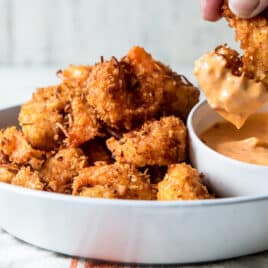
Coconut Shrimp
Ingredients
For the dipping sauce:
- 1/2 cup mayonnaise
- 1 tablespoon Sriracha
- 1 tablespoon Thai sweet chili sauce
For the coconut shrimp:
- 1/3 cup all-purpose flour
- Salt and freshly ground black pepper
- 2 eggs beaten
- 3/4 cup Panko bread crumbs
- 1 cup sweetened shredded coconut
- 1 pound jumbo raw shrimp thawed, peeled, and deveined
- 2 cups canola oil for frying
Instructions
- To make the dipping sauce, in a small bowl, whisk together the mayonnaise, Sriracha, and Thai sweet chili sauce. Chill until serving time.
- In a shallow dish, add flour and salt and pepper to taste (I like ½ teaspoon and ¼ teaspoon pepper). In a second shallow dish, add eggs and beat lightly. In a third shallow dish, combine panko and coconut. Stir to combine.
- Working with one shrimp at a time, dredge in flour and shake off excess. Dip in eggs and tap gently on side of dish to remove excess. Add to panko-coconut mixture and press gently until crumbs adhere. Transfer to a large plate and repeat with remaining shrimp (shrimp can be wrapped in plastic and refrigerated for up to 2 hours).
- Line rimmed baking sheet or large plate with 3 layers of paper towels. In a large saucepan over medium-high heat, heat canola oil until shimmering. Add shrimp in batches and fry until deep golden brown and cooked through, about 2 to 3 minutes per side (the shrimp should reach 120 degrees on an internal thermometer).
- Drain shrimp well on paper towels. Repeat with remaining shrimp and serve with sauce.
Recipe Video
Notes
- Mayonnaise: I adore the rich, umami flavor of Kewpie mayo alongside the sweet chili sauce and spicy Sriracha, but Hellman’s, Duke’s, Kraft, Best Foods, or any brand you prefer is perfect. Just be sure to steer clear of Miracle Whip; its too sweet for this purpose.
- Thai sweet chili sauce: More sweet than spicy, this glaze-like condiment is spiked with crushed red pepper flakes. Order a bottle online or look for it in your supermarket near the Sriracha.
- Panko bread crumbs: In most cases, I say you can use regular bread crumbs. Here, however, I think flaky panko is essential. This light Japanese-style breadcrumb is commonly used as to coat for deep-fried foods, including these Coconut Shrimp, for the crispiest results. Buy them at the store or make your own panko crumbs.
- Sweetened shredded coconut: For extra crunch, toast the coconut.
- Jumbo raw shrimp: Raw frozen shrimp (thawed) works beautifully for Coconut Shrimp. To thaw the shrimp, place the bag of seafood in a bowl and transfer it to the refrigerator the night before you plan to make this appetizer recipe. Jumbo shrimp come about 16 to 20 per pound (sometimes labeled U16 to U20). If the shrimp isn’t already peeled and deveined, follow the steps in Frequently Asked Questions for how to clean shrimp.
- Yield: This Coconut Shrimp recipe makes six appetizer-sized servings; about 4 to 5 large shrimp each.
- Storage: Transfer leftover coconut shrimp to an airtight container and refrigerate for up to 3 days. Reheat in the oven or an air fryer to 145 degrees.
Nutrition
Meggan Hill is a classically-trained chef and professional writer. Her meticulously-tested recipes and detailed tutorials bring confidence and success to home cooks everywhere. Meggan has been featured on NPR, HuffPost, FoxNews, LA Times, and more.
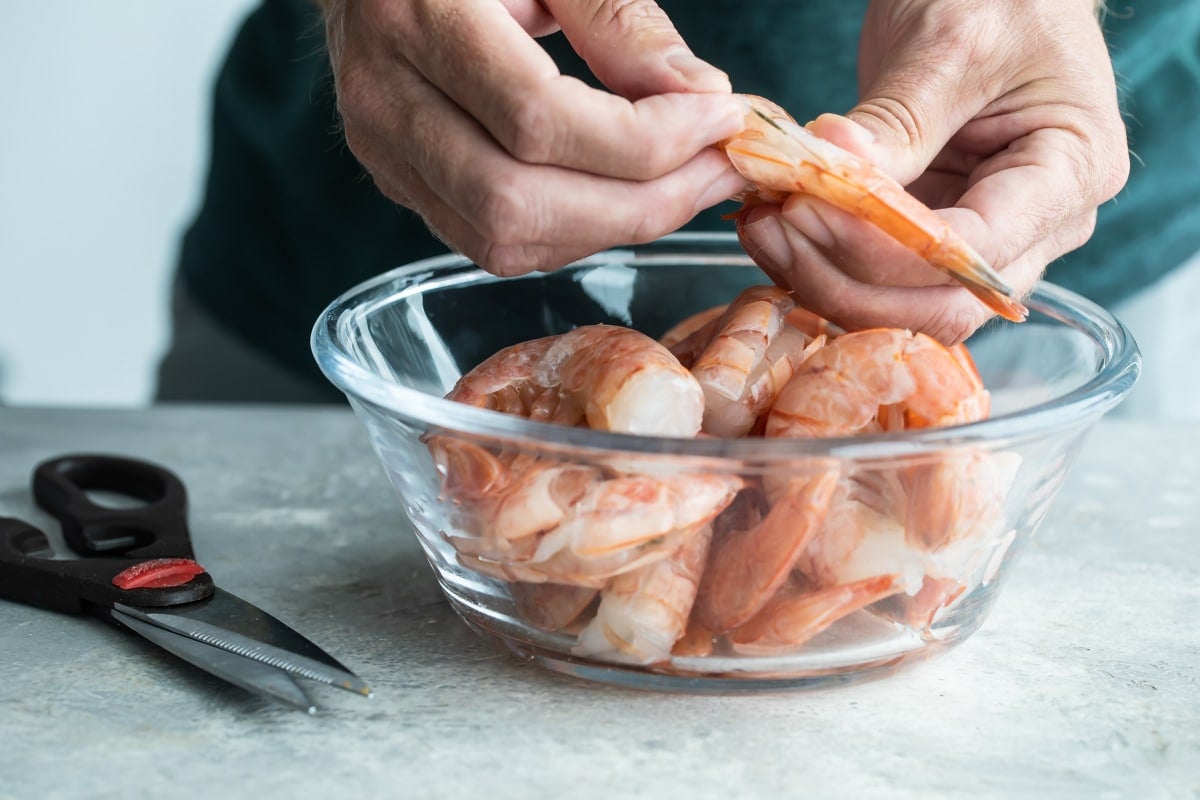
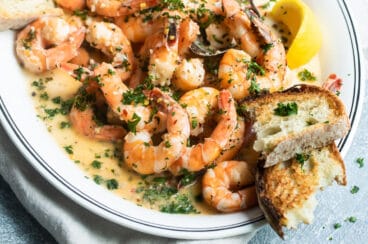
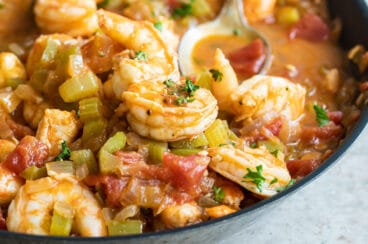
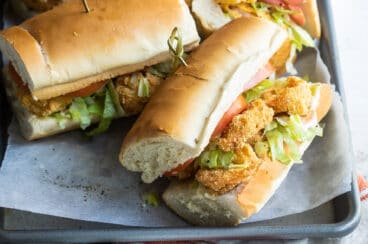
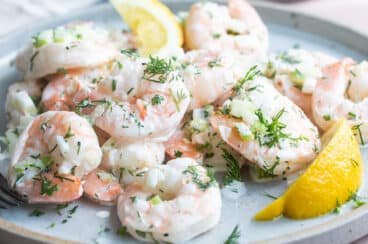
Absolutely loved this recipe and so did my husband. Definitely going to make it again.
I’m glad you both loved it, Alexis! – Meggan
A simple recipe, but my wife absolutely loves them.
Thanks, John! – Meggan
When I attended culinary school we were taught, “bread and rest, batter and fry.” After breading we were taught to place most items in the refrigerator for 15-30 minutes. The chill and rest allowed the items to set up as the flour, eggs and additional items hydrated and adhered together better. Here, the suggestion of covering the shrimp and placing the shrimp in the fridge accomplishes this well. If you bread and fry immediately, you’ll very likely have more of the coating fall off and burn in the oil.
When battering items we were taught to fry immediately so the batter didn’t run or drain off the items making it thin and blotchy.
I’ve been following this recommendation for over a decade now with wonderful results.
Thank you so much for writing, James! – Meggan
Hey there! I’m planning an Hawaiian “luau”-themed feast for my large family vacation at the beach this summer. I’ll have a kitchen at our rented beach house, , but I’m a big believer in doing as much prep work as possible ahead of time for these occasions to avoid killing myself on the day of the feast. Among other “luau” foods, I want to make coconut shrimp, and am wondering about the easiest way to make it for about 25 people. So I’m thinking I’ll need at least 5 lbs of large frozen/uncooked shrimp. I prefer not to do deep frying and would like to do it in the oven. I’m thinking I could do all the dredging/batter/coconut coating ahead and and refrigerate or freeze the coated uncooked shrimp in vacuum bags, to be baked in the oven. Or, I could completely cook the shrimp ahead and freeze, to be re-warm in the oven. What do you think would work best? Does thawing and re-freezing shrimp ruin it? Thanks for any ideas.
Hi DJ! This party sounds like so much fun! I agree with your plan. I would dredge and coat the shrimp and then freeze on a sheet pan so they retain their coating. Then I would vacuum seal them and cook from frozen. Cooking then reheating them will likely cause the shrimp to become rubbery. I hope you have a blast! – Meggan
Five stars and two thumbs-up
This is very delicious easy to
Make
Thanks again for your blog
And your time
You’re so welcome, Aeil! I’m so glad you loved them! – Meggan